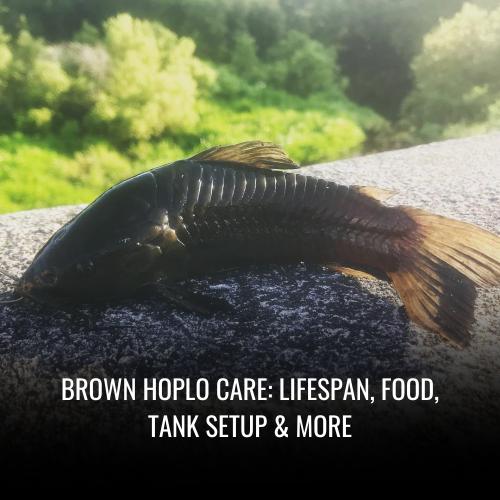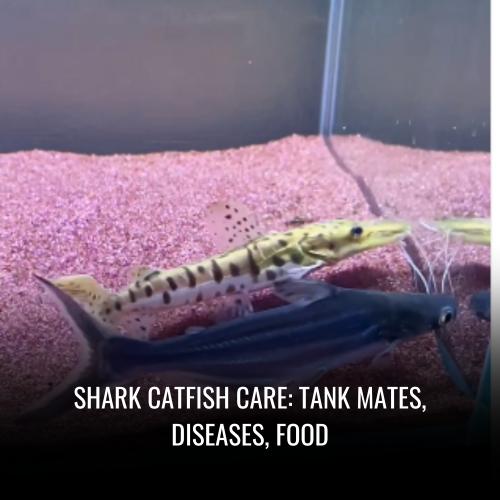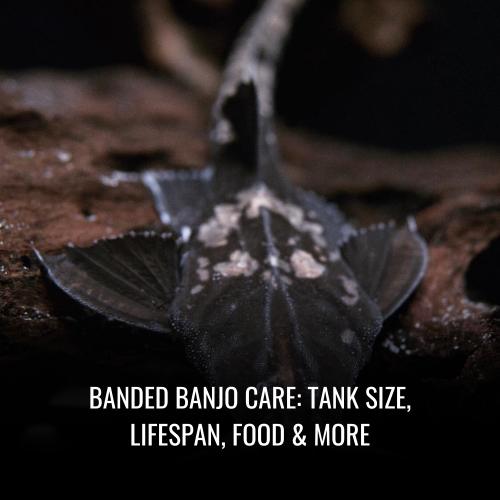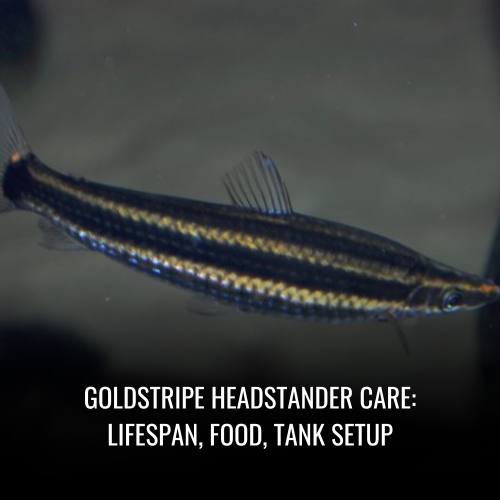Honeycomb Tatia Catfish Care: Diseases, Tank Setup, Food
This post contains affiliate links. As an Amazon Associate, we earn from qualifying purchases.
The Honeycomb Tatia Catfish, known among scientists as Duringlanis perugiae, presents a striking display of natural beauty in freshwater aquariums worldwide. Native to the biodiverse waters of South America’s Upper Amazon River Basin, this species thrives across Colombia, Peru, and Ecuador.
This catfish, with its distinctive honeycomb patterns and small adult size of approximately 2.5 inches, is not only an astonishing aquatic spectacle but also an intriguing subject for fish enthusiasts and professional aquarists alike.
| Attribute | Information |
|---|---|
| Scientific name | Dianema longibarbis |
| Common name | Honeycomb Tatia Catfish |
| Family | Auchenipteridae |
| Usual size in fish tanks | 2.5 inches (6.4 cm) |
| Recommended pH range | 6.5 – 7.5 |
| Recommended water hardness (dGH) | 5 – 12 dGH |
| Recommended temperature | 72°F to 78°F (22°C to 26°C) |
| Reproduction method | Egg layers, parental care by males |
| Origin | South America: Upper Amazon River Basin (Colombia, Peru, Ecuador) |
| Temperament to its own species | Peaceful |
| Temperament toward other species | Peaceful, should be kept with peaceful tank mates |
| Usual place in the tank | Bottom dweller |
| Lifespan | 5-8 years |
| Tank size requirement | Minimum 20 gallons for a small group |
| Filtration system | Efficient filtration system to maintain water quality |
| Sexual dimorphism | Females are typically larger and fuller-bodied than males |
| Substrate cleaning | Requires a soft substrate and some hiding spots |
Scientific Name
The Honeycomb Tatia Catfish belongs to the Siluriformes order, within the Auchenipteridae family and is scientifically recognized as Duringlanis perugiae. It was formerly classified under the genus Centromochlus, with Centromochlus perugiae as its scientific name, reflecting the taxonomic revisions that often occur as research into their genetic and morphological makeup advances.
Average Size
This compact species usually reaches an adult length of around 2.5 inches. Given this moderate size, the Honeycomb Tatia Catfish is an excellent choice for small to medium-sized aquariums, with a recommended minimum tank size of 15 gallons to provide ample space for natural behaviors and exercise.
Lifespan
Information on the exact lifespan of Honeycomb Tatia Catfish in the wild remains scarce. However, in a well-maintained aquarium environment, with appropriate water conditions, diet, and care, they can have a significant lifespan, with many catfish species living for several years.
Natural Habitat
The rivers and tributaries of the Amazon where the Honeycomb Tatia Catfish originates are rich in biodiversity. These waters typically have a slightly acidic pH and a warm temperature range of 26 – 28°C (76 – 82°F). Duringlanis perugiae has adapted to life in habitats abundant with leaf litter and driftwood, which provide essential cover for this cryptic species. This nocturnal fish tends to be more active during the night, foraging primarily for insects and insect larvae near the water’s surface, displaying their unique adaptation to their environment.
In the aquarium, to replicate its natural habitat, aquarists should aim to maintain the following conditions to support its health and natural behavior:
- Water pH: 6.0 – 7.5
- Temperature: 76-80°F (24-27°C)
- Ammonia: 0 ppm
- Nitrite: 0 ppm
- Nitrate: < 30 ppm
Furthermore, the aquarium setup should include elements like driftwood and artificial leaf litter to mimic their home in the wild, offering spaces for hiding and exploring. This approach not only provides a naturalistic setting but also helps to minimize stress on the fish, promoting a healthy and active aquarium life.
Appearance
Appearance significantly influences first impressions and can affect various aspects of a person’s life, including career opportunities and social interactions. It encompasses a multitude of elements, from clothing and grooming to body language and facial expressions. The importance of appearance is deeply rooted in cultural norms and societal standards, shaping perceptions of attractiveness and appropriateness.
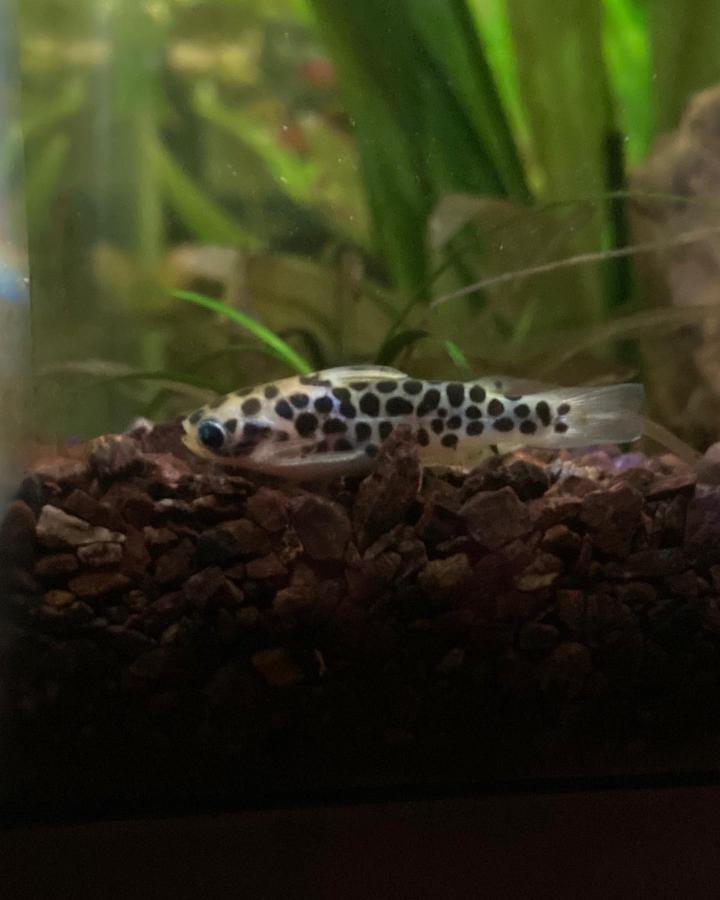
Effective personal grooming habits such as maintaining good hygiene, caring for skin, and managing hair can enhance an individual’s look, potentially altering how they are perceived by others. Despite this, it is essential to acknowledge that true attractiveness extends beyond the superficial; self-confidence and personality are intrinsic qualities that contribute to an individual’s charm and leave a lasting impact.
Here’s a quick overview in table form:
| Aspect of Appearance | Impact |
|---|---|
| Clothing & Grooming | Can influence perceived professionalism and attention to detail |
| Body Language | Affects how approachable and confident a person seems |
| Facial Expressions | Conveys emotions and engagement in social interactions |
| Personal Hygiene | Essential for favorable perceptions and health |
| Skincare & Hair Care | Reflects self-care and can affect self-esteem |
Remember, while outward appearance can open doors, it’s the inner self that sustains relationships and personal growth.
Behavior & Temperament
The Honeycomb Tatia Catfish, also known by its scientific name Centromochlus perugiae, is a unique and fascinating species hailing from the freshwater habitats of South America. Recognized for its striking appearance and docile nature, this species has garnered the attention of aquarists worldwide.
When considering its place in a home aquarium, its behavior and temperament are as important to understand as its physical characteristics.
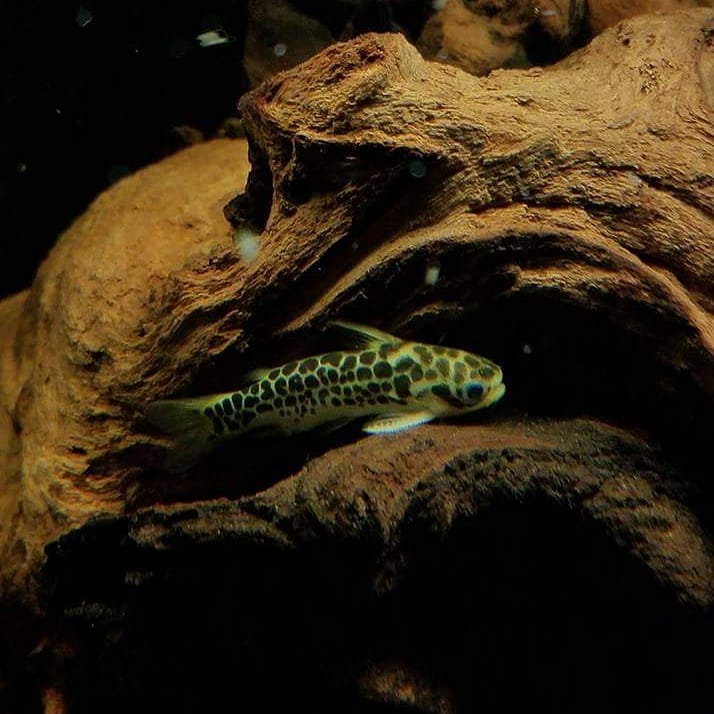
Are Honeycomb Tatia Catfish Fin Nippers?
A common concern for aquarists when selecting fish for a community tank is the potential for fin-nipping behavior. Fortunately, Honeycomb Tatia Catfish are not known to be fin nippers. Their natural diet consists mostly of insects and insect larvae rather than pursuing the fins of other fish.
Their feeding habits are primarily nocturnal, and during the day they prefer the seclusion of tank décor, making them an excellent choice for a peaceful community aquarium.
Are Honeycomb Tatia Catfish Aggressive To Each Other & Other Fish?
These attractive fish are celebrated for their tranquil and reserved nature. Both towards conspecifics and other species, the Honeycomb Tatia Catfish typically exhibits non-aggressive behavior.
Hidden amongst the leaf litter and driftwood during the day, they are cryptic species that choose secrecy over confrontation. They are especially non-confrontational, even with other members of their species, rarely showing territorial tendencies.
Are Honeycomb Tatia Catfish Friendly To Each Other & Other Fish?
Honeycomb Tatia Catfish are the epitome of friendly fish, displaying peaceful coexistence with a variety of tank mates. In the confines of an aquarium, they display a shy demeanor, generally avoiding interactions that could be perceived as hostile.
Their behavior is consistent among dense decorations and hiding spaces, embracing the shelter of the aquarium’s furnishings alongside both familiar and unfamiliar species.
Are Honeycomb Tatia Catfish Schooling Fish?
While some fish show an affinity for schooling behavior, Honeycomb Tatia Catfish do not typically school. They prefer to seek refuge individually within the welcoming shadows of driftwood and leaf litter.
At night, they emerge to forage for food near the water’s surface, each indulging in their solitary pursuit of nourishment. Despite this, they can be observed enjoying the company of their kind without the structured coordination of a schooling fish.
Can You Have Just One Honeycomb Tatia Catfish In The Tank?
These diurnal fish species can indeed be kept solitarily since they are not inherently schooling fish. A single Honeycomb Tatia Catfish in a tank will comfortably adapt, finding solace in its secluded enclaves.
That being said, providing a habitat with ample hiding spots ensures the well-being of this recluse species, replicating the concealed nature of its wild environment.
Do Honeycomb Tatia Catfish Need To Be In Groups?
Although they can thrive individually, Honeycomb Tatia Catfish may exhibit more dynamic behaviors when kept in small groups. Housing them in a group can decrease stress and allow aquarists to witness natural, peaceful interactions that these fish would display in their native South American waters.
Therefore, keeping a trio or more can be beneficial for the fish and can create an engaging and authentic experience for the observer. A balance should be struck to ensure each catfish has enough space to establish its territory while cohabiting harmoniously with its companions.
| Aspect of Grouping | Impact on Honeycomb Tatia Catfish |
|---|---|
| Social Interaction | Encourages peaceful behaviors |
| Stress Reduction | Promotes health and well-being |
| Natural Display | Enhances aquarium aesthetics |
| Territorial Establishment | Requires sufficient space |
Food & Diet
The Honeycomb Tatia Catfish, scientifically referred to as Centromochlus perugiae, is a strict carnivore with dietary preferences leaning heavily towards meaty foods. The main components of their diet in their natural environment of South American waters include a variety of prey such as insects, insect larvae, worms, small crustaceans, and fish larvae. In captivity, these feeding habits must be mimicked to ensure that Honeycomb Tatia Catfish receive the appropriate nutrition rich in animal proteins.
A diversified diet consisting of live, frozen, or dry food that is high in animal proteins is ideal for these fascinating fish species. Nighttime is when these catfish are most active, and thus, it is the optimal time to feed them. Offering food types that stay near the surface of the water, like floating flakes, granules, or white mosquito larvae, caters to their natural hunting behavior. However, in habitats where they are the sole residents, Honeycomb Tatia Catfish may exhibit increased daytime activity and willingness to feed.
| Food Type | Description |
|---|---|
| Insects | Main part of the diet in nature, includes various types of insects |
| Insect Larvae | Consumed in nature, provides a source of protein for the fish |
| Worms | Eaten in the wild, adds variety to the diet and provides essential nutrients |
| Little Crustaceans | Part of the natural diet, offers a source of protein and other nutrients |
| Small Fish | Preyed upon in the wild, provides a source of animal protein |
| Fish Larvae | Consumed by C. perugiae in nature, offers a source of nutrients and protein |
| Live Food | Can be fed to the fish in captivity, as long as it contains animal proteins |
| Frozen Food | Suitable for feeding in captivity, includes frozen insects, larvae, worms, and other animal proteins |
| Dry Food | Can be fed to the fish in captivity, as long as it contains animal proteins |
| Flakes | Floating food that is taken well by C. perugiae, ideal for feeding the fish |
| Granules | Floating food that is accepted by the fish, provides necessary nutrition |
| White Mosquito Larvae | Taken well by C. perugiae, provides a source of food for the fish |
Do Honeycomb Tatia Catfish Eat Algae?
Unlike many other freshwater fish species, Honeycomb Tatia Catfish do not primarily eat algae. Their nocturnal lifestyle dictates that they spend daylight hours hidden in crevices provided by driftwood, leaf litter, or submerged logs in your tank. They fulfill their dietary needs by hunting for insects and insect larvae at the water’s surface under the cover of darkness rather than actively seeking out algae.
Although they might occasionally graze on algae, this behavior is not sufficient to classify them as effective algae cleaners in an aquarium setting. Aquarists looking to control algae growth should consider other species that specialize in such dietary habits.
Do Honeycomb Tatia Catfish Eat Shrimp?
Honeycomb Tatia Catfish are known to ingest a variety of small invertebrates in the wild, and in the constraints of an aquarium, small shrimp might become part of their menu. Despite their peaceful nature, the predatory instincts of these catfish can prompt them to consume small shrimp if they are within reach.
Therefore, for aquarists hoping to maintain a diverse ecosystem within their tank, ensuring that their feeding needs are met with appropriate live or frozen food options is crucial. Special attention should be given when housing Honeycomb Tatia Catfish with shrimp, as they may become unintended prey.
Do Honeycomb Tatia Catfish Eat Bloodworms?
Bloodworms are a favored food choice for Honeycomb Tatia Catfish. These substantial protein sources can be offered freeze-dried or frozen, providing variation in the diet. Freeze-dried bloodworms have the advantage of floating, aligning with the catfish’s preference for surface feeding. Moreover, frozen bloodworms may offer nutritional benefits that aid in preserving the vibrant coloration of these fish.
A key component to consider in the care of these fish is the water parameters in the tank. For optimal health, the water pH should rest between 6.0-7.5, with a water temperature maintained between 76-80°F. It is also imperative to recognize the nocturnal and cryptic nature of Honeycomb Tatia Catfish when planning their feeding schedule and tank environment.
Do Honeycomb Tatia Catfish Eat Mosquito Larvae?
Being nocturnal surface feeders, Honeycomb Tatia Catfish are inclined to consume mosquito larvae in the wild, and this behavior is often observed in home aquariums as well. They emerge at night from their daytime hideouts to actively pursue insect larvae, including those of mosquitoes, along the surface.
Recognized as peaceful fish, the Honeycomb Tatia Catfish can coexist with other tankmates while also contributing to the control of mosquito larvae populations within the tank. Aquarium enthusiasts are encouraged to engage in independent research to fully understand the preferences and needs of their Honeycomb Tatia Catfish, potentially considering variables such as age, sex, and origin.
Do Honeycomb Tatia Catfish Eat Planaria?
While it is true that Honeycomb Tatia Catfish forage for a variety of insect and insect larvae, there is no explicit evidence that they feed on Planaria, which are non-parasitic flatworms. The nocturnal habits and surface-oriented feeding patterns of these catfish do not typically involve the deliberate consumption of flatworms like Planaria.
Their diet is structured around those creatures that are found near the tank surface, where these catfish are most active during the night. It is crucial to provide a diet that satisfies their carnivorous nature to maintain a well-balanced and vigorous community aquarium.
Do Honeycomb Tatia Catfish Eat Plants?
Given their inherent insectivorous tendencies and nocturnal nature, Honeycomb Tatia Catfish are not likely to be interested in eating plants in their habitat. Even though a small amount of plant matter may be incidentally ingested in the wild, the diet of these catfish in captivity is generally absent of plant-based foods.
Aquarists typically provide these fish with high-quality sinking pellets along with frozen and live offerings. Honeycomb Tatia Catfish make for an excellent addition to a thriving planted aquarium. Their moderate activity levels and non-destructive behavior ensure that they are not a threat to aquatic plants, allowing for a well-balanced ecosystem within the tank.
Sexing: Male vs Female
Determining the sex of the Honeycomb Tatia Catfish, Centromochlus perugiae, is an intriguing aspect for aquarists and breeders alike. Observing the differences between males and females can be done by paying close attention to several physical characteristics.
Generally, males exhibit a pointed and narrower anal fin, which is similar to the gonopodium found in species like the Xiphophorus hellerii, while females display a conventionally shaped anal fin. The body shape also provides cues; females tend to be larger and rounder, particularly discernible when gravid, whereas males have a more streamlined form.
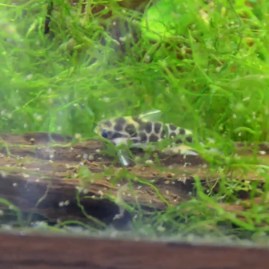
During fertilization, males participate by fertilizing the female’s eggs over her reshaped anal fin. Post-fertilization, females internally store the sperm to fertilize the eggs. In their search for suitable spawning locations, such as small surface caves or driftwood crevices, female Honeycomb Tatia Catfish meticulously tend to their eggs.
They lack large fins for fanning water over the eggs; instead, they use rapid mouth and gill movements to oxygenate the developing larvae.
Below is a table highlighting key differences for sexing Honeycomb Tatia Catfish:
| Feature | Male | Female |
|---|---|---|
| Anal Fin | Pointy and narrow | Normal shaped |
| Body Shape | Streamlined | Bigger and rounder, notably when pregnant |
| Fertilization Role | Fertilizes over female’s reshaped fin | Stores sperm, searches for spawning spots |
| Egg Care | Not applicable | Uses mouth and gill movements for oxygen |
Remember these characteristics to identify and understand the behavior of each sex within this peaceful community fish species.
Honeycomb Tatia Catfish Tank Mates
The Honeycomb Tatia Catfish (Centromochlus perugiae) is an enchanting addition to freshwater aquariums, tracing its origins to the tranquil waters of South America. As a nocturnal and secretive species, the Honeycomb Tatia Catfish spends much of the day concealed in driftwood and among leaf litter, emerging at night to surface feed on insects and their larvae.
Therefore, maintaining a suitable living environment that mimics their natural habitat is crucial. When selecting tank mates, aim for peaceful fish that respect the Honeycomb Tatia’s nighttime routines. Suitable companions include other peaceful bottom-dwellers, small to medium-sized catfish, non-aggressive dwarf cichlids, and small characins.
These fish create a serene community, ensuring your Honeycomb Tatia feels at home. Avoid pairing with aggressive eaters to prevent competition for food and minimize stress.
Consider the following list of ideal tank mates:
| Peaceful Bottom Dwellers | Dwarf Cichlids | Small Characins |
|---|---|---|
| Corydoras Species | Apistogramma Species | Tetra Species |
| Otocinclus Catfish | Keyhole Cichlids | Hatchetfish |
By embracing these guidelines, aquarists can ensure their Honeycomb Tati Catfish thrive alongside friendly and compatible tank mates, making for an attractive and peaceful fish community.
Aquarium Setup
Setting up an aquarium for the intriguing Honeycomb Tatia Catfish (Centromochlus perugiae) involves careful consideration to recreate an environment similar to their natural habitat, ensuring their health and contentment.
It’s essential to provide them with adequate space, stable water parameters, and the appropriate technical equipment to replicate the sequestered regions of South American rivers they hail from.
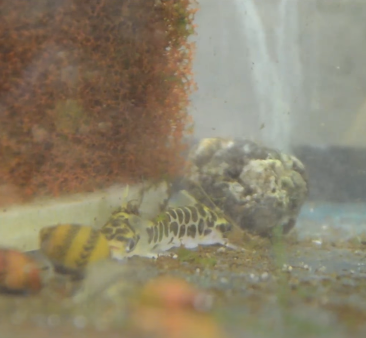
Ideal Tank Size
When deciding on tank size for your Honeycomb Tatia Catfish, it’s important to remember that these catfish prefer to have enough room to roam at night. An 80 cm aquarium (approximately 20 gallons or more) is recommended for the Honeycomb Catfish, while the Honeycomb Woodcat and Yellow Honeycomb Wood Catfish can be comfortable in a slightly smaller setup of 15 gallons.
Larger tanks not only accommodate their exploratory nocturnal behavior but also contribute to stabilizing water parameters, resulting in a more stress-free environment for these cryptic species. Here’s an overview of the minimum suggested tank sizes:
| Fish Species | Minimum Tank Size |
|---|---|
| Honeycomb Tatia Catfish | 20 gallons |
| Honeycomb Woodcat | 15 gallons |
| Yellow Honeycomb Wood Catfish | 15 gallons |
Ideal Water Parameters
For the C. perugiae, water quality is of the utmost importance. They thrive in a pH range of 6.0 – 7.5, which is slightly acidic to neutral, and prefer warmer waters with temperatures kept consistently between 76-80°F. Ammonia and nitrite levels should always be at 0ppm, and nitrates should be kept below 30ppm. Careful attention to these parameters will not only support the health and well-being of the Honeycomb Tatia Catfish but also accommodate other peaceful community fish that may share their habitat.
Filtration
A robust filtration system is a crucial component of the aquarium setup for maintaining a clean and healthy environment for the Centromochlus perugiae. An internal filtration system is an excellent choice as it helps keep the water clear of waste and debris while ensuring adequate water circulation. Ensuring the filter has a gentle flow will prevent stress for the Honeycomb Tatia, which prefers calm waters reminiscent of their natural settings in the wild.
Lighting
The Honeycomb Tatia Catfish doesn’t have a strict requirement for lighting in their dwelling due to their nocturnal nature. However, if the tank contains live plants like Aponogeton or other fish that require lighting, it will become necessary. Aponogeton plants are adaptable and can grow well in low to moderate light environments, thus lighting should be set up to meet the requirements of the tank’s most light-dependent inhabitants without overly disturbing the Honeycomb Tatia Catfish’s preferred dim environment.
In summary, creating an ideal aquarium setup for the Honeycomb Tatia Catfish calls for attention to tank size, water quality, efficient filtration, and nuanced lighting – all of which ensure that these peaceful and attractive bottom dwellers can live a healthy, stress-free life while adding a touch of the bizarre and beautiful to your aquatic community.
Common Possible Diseases & Prevention
Aquarium enthusiasts should be vigilant about the wellbeing of their aquatic pets, including the Honeycomb Tatia Catfish. Two prevalent diseases that can afflict freshwater fish are Ich and Fin Rot.
Ich is recognized by telltale white spots on the body and fins, a sure sign of this parasitic infection. Efficiently managing Ich involves upholding pristine water conditions and circumventing abrupt alterations in water temperature and quality. Regular tank maintenance is key in preventing such parasitic attacks.
Fin Rot, on the other hand, stems from bacterial infestation, resulting in the degradation of the fins and tail. To fend off this bacterial onslaught, one must ensure the aquarium is not overpopulated and that the water is free from excessive detritus.
Here are succinct, preventative measures to aid in keeping your aquatic habitat disease-free:
| Disease | Prevention Methods |
|---|---|
| Ich | – Clean water. |
| – Stable water temperature and quality. | |
| Fin Rot | – Avoid overcrowding. |
| – Remove waste promptly. |
Regular observation for any abnormal behavior or appearance in fish is crucial. Additionally, implementing quarantine protocols for new additions can help safeguard your community from disease outbreaks. Maintaining a healthy environment for your Honeycomb Tatia Catfish not only ensures their longevity but also preserves the serene beauty of your aquarium.
Breeding Honeycomb Tatia Catfish In Aquarium
Breeding Honeycomb Tatia Catfish in an aquarium is a fascinating endeavor for fish enthusiasts. These fish are known as cave spawners, requiring hiding nooks for spawning success. To simulate their natural habitat, include an array of caves and sheltered spots in your tank setup.
To induce breeding conditions, a tweak in water parameters is essential. Aim for a slightly acidic pH between 5.5-6.5 and keep water temperatures cozy within 73-77°F. Before attempting to breed, pairs should be conditioned with a mix of live and frozen foods to ensure they’re in prime health.
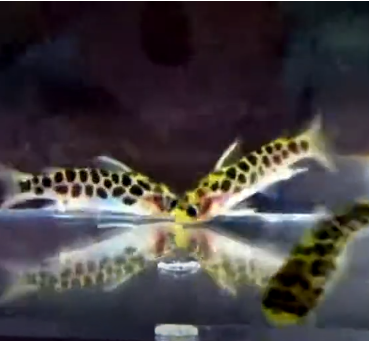
The breeding ritual culminates with the female laying adhesive eggs on the cave ceiling, which are then meticulously guarded by the parents. Once the eggs hatch, the fry will initially consume their yolk sacs, transitioning to small live feeds as they develop.
Ensuring the fry thrive involves providing a sanctuary of hiding spots and a calm water flow. This attentive approach will help in nurturing the next generation of these peaceful community fish.
| Water Parameter | Required Condition |
|---|---|
| pH | 5.5-6.5 |
| Temperature | 73-77°F (23-25°C) |
Breeding Checklist:
- Array of caves for spawning.
- Water pH: 5.5-6.5.
- Temperature: 73-77°F.
- Varied diet: live and frozen foods.
- Ample hiding spaces for fry.
- Gentle water circulation.
By closely monitoring and modifying these conditions, breeding Honeycomb Tatia Catfish can be a rewarding experience for any aquarist.
Are Honeycomb Tatia Catfish Easy To Keep?
Honeycomb Tatia Catfish, bearing the scientific name Centromochlus perugiae, are often celebrated by aquarium hobbyists as a cool fish that bring a hint of South American rivers to home tanks. These fish species are recognized for their adaptability and hardiness, traits that make them reasonably easy to care for.
With their origins in the serene waters flowing through Peru, Colombia, and Ecuador, Honeycomb Tatia Catfish are accustomed to dwelling among leaf litter and driftwood. In captivity, they thrive in environments that recreate aspects of their natural habitat—dimly lit aquariums furnished with hiding places that mimic submerged logs or dense foliage.
To ensure these attractive fish remain healthy, they primarily require an environment that maintains stable water parameters. Specifically, a temperature range of 76-80°F and a pH level between 6.0 and 7.5 will suit them well. Moreover, these nocturnal hunters are not wasteful feeders, thus they contribute minimally to tank pollution, aiding in maintaining a stable aquatic environment. Their preference for hunting at night means they are relatively inactive during the day, demanding less immediate attention from their keepers.
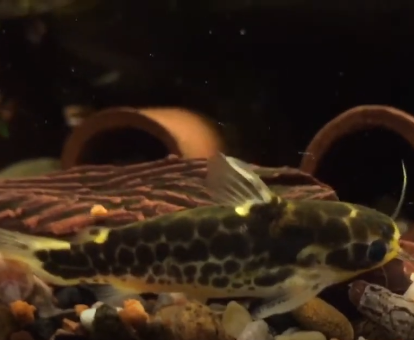
Are Honeycomb Tatia Catfish Sensitive To Water Changes?
Honeycomb Tatia Catfish possess a striking ability to adapt to various aquarium conditions, owing to their hardiness. Despite this, they do display a degree of sensitivity to abrupt changes in water parameters. In the wild, they inhabit stable environments—tannin-rich waters with consistent chemical composition that are typical of the middle Amazon and its tributaries. Here, they flourish among dense leaf litter and submerged logs, which foster an environment with minimal temperature and pH fluctuations.
In the home aquarium, maintaining consistent water parameters is essential to keeping these peaceful fish content and healthy. Sudden shifts in pH or temperature can lead to stress, making them susceptible to illness. It is critical to make any necessary changes to water chemistry gradually, giving these fish ample time to adjust without undue stress. Careful acclimation is particularly important when introducing Honeycomb Tatia Catfish to a new tank or following water changes, ensuring the transition is as smooth as possible.
Fishkeepers who maintain a keen eye on tank environment stability will find that Honeycomb Tatia Catfish are resilient companions. Regular testing and monitoring can flag potential issues early, allowing for gentle corrections and fostering prosperous conditions for these cryptic species.
Are Honeycomb Tatia Catfish Sensitive To Ammonia?
Zero tolerance is the standard for ammonia levels when it comes to the wellbeing of Honeycomb Tatia Catfish. These fish are notably sensitive to the presence of ammonia in their aquatic environment, a trait common among many fish species. Ammonia, a byproduct of organic waste decomposition, can reach harmful concentrations quickly in an inadequately cycled or overstocked tank.
Maintaining an ammonia level of 0ppm is vital for Honeycomb Tatia Catfish, as even minimal exposure can lead to stress and can compromise their immune system. Chronic exposure to ammonia can result in severe health issues and potentially fatal outcomes. It is imperative for aquarists to establish and maintain a robust biological filtration system that can efficiently convert ammonia into less harmful substances, such as nitrite and then nitrate.
Regular water testing is a fundamental practice for any aquarist, especially those with sensitive species like Honeycomb Tatia Catfish. Ensuring the ammonia levels are consistently undetectable supports the overall health of these fish and prevents the risk of potential health complications.
Are Honeycomb Tatia Catfish Sensitive To Copper?
The peaceful Honeycomb Tatia Catfish exhibit a particular sensitivity to copper, a chemical element that can be found in various aquarium products such as algae treatments, certain medications, and even some tap water sources. While copper is used to treat different fish ailments, for Honeycomb Tatia Catfish, exposure to it should be carefully managed.
Copper’s toxic nature to these fish is compounded by the conditions of their natural habitats, the clear waters of South America, which do not contain high levels of copper. When present in the aquarium water, copper can adversely affect the health of Honeycomb Tatia Catfish, leading to stress and potentially life-threatening situations.
To safeguard the health of these fish, aquarists must avoid using copper-based treatments or ensure they are used in strict accordance with the species’ tolerance levels. It’s essential to employ copper test kits to monitor copper concentration in the tank water, acting swiftly to rectify any elevated levels. By taking such precautions, the innate charm and tranquility of Honeycomb Tatia Catfish can be preserved, adding to the serenity of a community tank.


